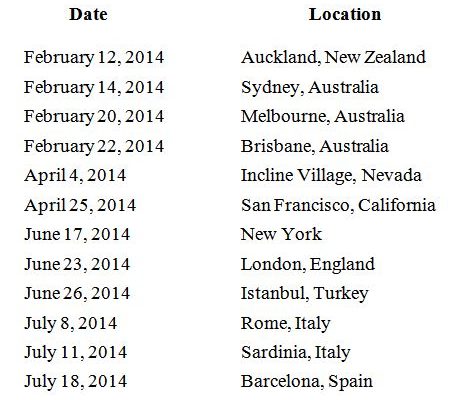
One of my many alma maters, the University of Southern California, announced that they had received their largest private donation ever. As a third generation alumni of this fanatical football factory (I went to school with Mark Harmon, Lynn Swan, and, oops, OJ Simpson), I still receive their alumni newsletter, where I learned the good news.
David and Dana Dornsife gave $200 million to the downtown Los Angeles home of the Trojans. The money has been used to fund the College of Letters, Arts and Sciences, which has been renamed after them.
Dornsife made his fortune as the owner of Herrick Corp., a Stockton based maker of the prefabricated steel that was used to build many of the skyscrapers in the center of Los Angeles.
The gift tops the university's previous largest gift from George Lucas, of Star Wars fame, who in 2006 contributed $175 million to USC's film school, which he once attended with another legendary director, Steven Spielberg.
For the record, the largest charitable contribution to a university in history was the $600 million that Gordon Moore, of Moore?s Law fame and a founder of Intel (INTC), gave Caltech in nearby Pasadena. As a teenager, I used to sit in on the math classes there. Notice that all of these big donations to education are happening in California.
Tommy Trojan will no doubt be happy, provided that a Bruin from UCLA has not stolen his sword again, or painted him blue. And don?t ask me about ?Old Tire Biter.?
Global Market Comments
February 7, 2014
Fiat Lux
Featured Trade:
(TAKING OFF FOR THE ANTIPODES),
(SATURDAY FEBRUARY 22 BRISBANE AUSTRALIA STRATEGY LUNCH),
(TESTIMONIAL)
I will be departing for my Mad Hedge Fund Trader?s 2014 Australia and New Zealand tour as soon as I finish writing today?s letter. During the next 18 days, I will fly 22,000 miles, dining with my abundance of readers in the southern hemisphere.
I am leaving you in good hands with a clean conscience. The markets graciously allowed me to exit my three remaining positions with nice profits, placing readers in the enviable position of being up +5.42% for the month of February, 8.46% year to date, and up +130.96% since inception. This was during a period when the Dow Average dove a ferocious 7.6%.
All 13 new Trade Alerts issued so far in 2014 have been profitable. The one loser we realized, in Softbank (SFTBY) shares, was carried over from 2013.
Hard earned experience has taught me that reaching for more than this in these troubled, volatile, and unpredictable times could result in my hand getting chopped off. Better to continue on the year with all ten digits intact, so as to type the Trade Alerts faster.
I will be meeting the CEO?s of major multinationals, the heads of sovereign wealth funds, senior officials at ministries of finance and central banks, and, of course, lots of hedge fund managers.
These meetings are extremely helpful in updating my view on all asset classes, as well as getting a real time read on the state of the global economy. You will be the direct beneficiaries of any insights I may glean, as they will directly translate into new, profitable trades upon my return to America.
Until then, I will be rerunning my favorite pieces from past letters, which have been updated for market relevance and accuracy. Thousands of new subscribers have recently joined the Mad Hedge Fund Trader community and will be reading them for the first time. Many of the rest of you were either too busy to catch them the first time, or completely forgot them.
I doubt that I will be issuing any new Trade Alerts during my trip. With these incredibly volatile market conditions, you have to be glued to your screen at all times, or you are toast. In Australia the New York market opens at 1:30 AM and closes at 8:00 AM local time. Given my packed schedule of strategies luncheons and speaking engagements, I really need a full night of sleep to carry it off.
Quite honestly, I am also getting kind of tired and can use a rest. Over the past two months, not only did I keep up my 1,500 word a day torrent of ideas and opinion, I also managed to pump out 44 trade alerts, nearly all of which made money.
This workload would crush most 30 year olds, and I just turned 62. Maybe I can catch some shuteye during the 45 hours that I will be spending on planes over the blue Pacific.
During my off hours, I will be mountain climbing on New Zealand?s North Island, where the Lord of the Rings trilogy was filmed, surfing on the western beaches, going wave hopping while piloting a small plane along the coast of New South Wales, and diving off a small coral island on the Great Barrier Reef.
My business strategy towards life has always been to under promise and over deliver. I believe that I have done this in spades with the Trade Alert mentoring program.
Not a day goes by without an email from a satisfied subscriber telling me that I have paid for a college education, a loved one?s chemotherapy, or given new meaning to long, but tired careers. Coming at a time in my life when there are clearly more years behind me than ahead, when the hike has fewer miles ahead than behind, they make it all worth it. Please keep them, coming.
Well, I?ve got to finish my packing, as the limo will arrive shortly. New Zealand and Australia are 220-volt countries, but don?t use the same plugs as England. So I dove into my voluminous bag of international power adapters and think I found the right ones. I?ve turned off the heat and the hot water, plugged in the Tesla, and took the battery out of the Toyota. I put the mail on old and gave all of my perishable food to my kids. It?s time to go.
If you wish to join me at any of the lunches, there are still tickets available for sale for all. Just go to my store. Here is the schedule:
Auckland, New Zealand - Wednesday, February 12
Sydney, Australia - Friday, February 14
Melbourne, Australia - Thursday, February 20
Brisbane, Australia - Monday, February 22
See you there
John Thomas
The Mad Hedge Fund Trader
Global Market Comments
February 6, 2014
Fiat Lux
Featured Trade:
(THURSDAY FEBRUARY 20 MELBOURNE, AUSTRALIA STRATEGY LUNCH)
(MAD HEDGE FUND TRADER SURGES AHEAD WITH A 5.78%),
(TLT), (UNG), (AAPL)
(DINNER WITH ELIOT SPITZER)
iShares 20+ Year Treasury Bond (TLT)
United States Natural Gas (UNG)
Apple Inc. (AAPL)
The red hot performance of the Mad Hedge Fund Trader?s Trade Alert Service has maintained its blistering pace from last year, picking up another 6.49% profit in the first two trading weeks of 2014.
The Dow Average was down 6.2% during the same period pegging my outperformance of the index at a stunning 12.7%. Since the beginning of 2013, I am up 77%. 2013 closed with a total return for followers of 67.45%.
The three-year return is now an eye popping 132%, compared to a far more modest increase for the Dow Average during the same period of only 26%. That brings my averaged annualized return up to 41.7%.
This has been the profit since my groundbreaking trade mentoring service was launched in 2010. It all is a matter of the harder I work, the luckier I get.
The hot streak continues.
The smartest thing I did in the past year was to let all of my options expire on January 15, and then moved to an 80% cash position. That spared me the angst, the soul searching, and the sleepless night caused by the 10% correction that followed in the Dow Average.
This set me up to cherry pick the most extreme market moves. But this time was different. Instead of returning to call spreads, I adopted an outright put option strategy.
This allowed me to pick up highly leveraged short positions in Treasury bonds and natural gas, while risking only 5% of my capital with each. Don?t people know that polar vortexes only come in pairs? I guess no one studies physics anymore. When the markets broke, a sharp rise in volatility also contributed to the P&L.
To top it all, Steve Jobs chipped in again, even though he has been dead for 2 ? years. My call spread in Apple shares PROFITABLY came home once more.
My esteemed colleague, Mad Day Trader Jim Parker, had no small part of this success. Since the market became technically and momentum driven, I have been confirming with him before sending out every Trade Alert. Together, out success rate is 100%.
What would you expect with a combined 85 years of market experience between the two of us? Followers are laughing all the way to the bank.
Don?t forget that Jim clocked an amazing 2013 staggering 374%. That is just for an eight-month year!
The coming year promises to deliver a harvest of new trading opportunities. The big driver will be a global synchronized recovery that promises to drive markets into the stratosphere in 2014.
The Trade Alerts should be coming hot and heavy. Please join me on the gravy train. You will never get a better chance than this to make money for your personal account.
Global Trading Dispatch, my highly innovative and successful trade-mentoring program, earned a net return for readers of 40.17% in 2011, 14.87% in 2012, and 67.45% in 2013.
The service includes my Trade Alert Service and my daily newsletter, the Diary of a Mad Hedge Fund Trader. You also get a real-time trading portfolio, an enormous trading idea database, and live biweekly strategy webinars. ?Upgrade to?Mad Hedge Fund Trader PRO?and you will also receive Jim Parker?s?Mad Day Trader?service.
To subscribe, please go to my website at www.madhedgefundtrader.com, find the ?Global Trading Dispatch? box on the right, and click on the blue ?SUBSCRIBE NOW? button.
Global Market Comments
February 5, 2014
Fiat Lux
Featured Trade:
(FRIDAY FEBRUARY 14 SYDNEY, AUSTRALIA STRATEGY LUNCH),
(THREE CHARTS THAT WILL TURN THE MARKETS),
(TLT), (TBT), (FXY), (YCS), (SPX), (BAC), (C), (GLD),
(GRAPES OF WRATH REDUX),
(TESTIMONIAL)
iShares 20+ Year Treasury Bond (TLT)
ProShares UltraShort 20+ Year Treasury (TBT)
CurrencyShares Japanese Yen Trust (FXY)
ProShares UltraShort Yen (YCS)
S&P 500 Index (SPX)
Bank of America Corporation (BAC)
Citigroup Inc. (C)
SPDR Gold Shares (GLD)
Global Market Comments
February 4, 2014
Fiat Lux
Featured Trade:
(THREE CORRECTIONS FOR THE PRICE OF ONE),
(TLT), (TBT), (SPY),
(CHINA?S VIEW OF CHINA),
(FXI), (EEM)
(FEBRUARY 12 AUCKLAND NEW ZEALND STRATEGY LUNCH)
iShares 20+ Year Treasury Bond (TLT)
ProShares UltraShort 20+ Year Treasury (TBT)
SPDR S&P 500 (SPY)
iShares China Large-Cap (FXI)
iShares MSCI Emerging Markets (EEM)
Global Market Comments
February 3, 2014
Fiat Lux
Featured Trade:
(FEBRUARY 5 GLOBAL STRATEGY WEBINAR),
(NOW WE?RE COOKING WITH GAS),
(AMERICA?S DEMOGRAPHIC TIME BOMB),
(TESTIMONIAL)
Global Market Comments
January 31, 2014
Fiat Lux
Featured Trade:
(TIME TO SELL NATURL GAS),
(UNG), (USO),
(MAD HEDGE FUND TRADER 2014 GLOBAL STRATEGY LUNCHEON SCHEDULE)
United States Natural Gas (UNG)
United States Oil (USO)
Come join me for lunch at the Mad Hedge Fund Trader?s Global Strategy Luncheons, which I will be conducting around the world throughout 2014. Please find the schedule for the next six months below.
To warm you up, I?ll email you a PowerPoint presentation covering the broad range of topics we may cover, which is pretty much everything on the planet.? An excellent meal will be followed by a wide-ranging discussion and a prolonged question and answer period.
I?ll be giving you my up to date view on stocks, bonds, currencies commodities, precious metals, and real estate. I also hope to provide some insight into America?s opaque and confusing political system. And to keep you in suspense, I?ll be throwing a few surprises out there too.
The cost is modest. My goal is to meet the readers in person, find ways to improve my products, learn about new trading opportunities, and break even on the cost. If I can gain further insights on the true state of the global economy, that?s a plus too.
I?ll be arriving at 11:00 and leaving late in case anyone wants to have a one on one discussion, or just sit around and chew the fat about the financial markets. The formal lunches start at 12:00.
The events are held at downtown five star hotels and private clubs that are easily accessible, the details of which will be emailed with your purchase confirmation.
I look forward to meeting you, and thank you for supporting my research. To purchase tickets for the luncheons, please go to my online store.










